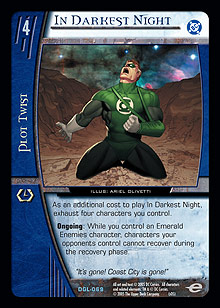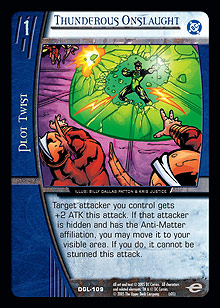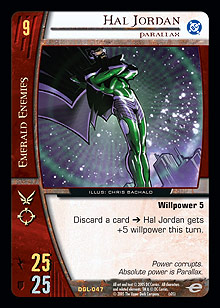I'll admit, I'm a
Green Lantern Corps newb. Sure, I've played a bit of Sealed with the set. I've discussed draft and Sealed Pack strategies with people who are frankly better at Sealed Pack formats than I, but all in all? Still a newb. You'd be surprised just how hard it is to find a draft when you spend most of your time on planes to and from events that you're not playing at.

My wallowing and self-deprecation have a point. The odds are good that if you're reading this you're in the same boat I'm in. There's no shame to it—the reality is that
Green Lantern Corps has only been on the streets for three or four weeks at this point and Sealed Pack play can be difficult to find. This weekend's PC and its accompanying $10K today are the first two major events to use the
Green Lantern Corps draft format, so there isn't a great deal of general consensus for armchair TCG fans to use for developing opinions and play habits. That said, after just a few rounds of play in the PC's
Green Lantern Corps draft segment, there are some trends and base mechanics that really influence the format and keep it from being just another regurgitated experience. Let's take a look at the set-wide tendencies that make
Green Lantern Corps a different beast from anything presented in the past.
The type and number of useable plot twists in the set are the number one defining element in the eyes of most players. Josh Wiitanen said it best when he was discussing the $10K. “There are like, thirty-seven combat-oriented plot twists in the set. That alone changes drafting entirely.”
He's completely right. Depending on how you define “combat-oriented,” Green Lantern Corps has thirty to forty such plot twists, more than half of which are generic and can be used by a wide variety of characters. That means that unlike previous sets, you don't need to prioritize curve-jumping plot twists over characters nearly as often. In fact, while most players of Marvel Knights and Superman, Man of Steel drafts would definitely prioritize plot twists over characters, such decisions won't be made nearly so often by experienced Green Lantern Corps drafters.

The influx of useful plot twists that are not affiliated with a set team also cracks open the format for creativity and flexibility. Unlike
Marvel Knights, where most good plot twists are team-stamped or brutally costed to all but one team, it's relatively easy to use a wide variety of plot twists in any given draft deck. Again, this places less of an emphasis on plot twists. While excellent plot twists such as
Thunderous Onslaught and
Sweeping Up were still hot commodities, generic combat twists were slower to go than they would be in other sets.
The massive amount of characters with flight and range also influences the drafting environment. Formation is not less important than it might be in other formats, but is definitely less effective. Cards like
Tomar Tu and
Coast City that shut down flight are incredibly valuable in the right matchups, and with sixty-eight characters in the set with flight, one can easily extrapolate the value of cards that protect characters. There are lots of smaller characters that have seen play today, especially
G'Nort, and while the advantage these characters can create is potentially massive, they're also very weak when it comes down to raw stats. Though
Catcher's Mitt is a spectacular answer to this problem, it's not an easy pull, so a solid understanding as to the strengths and weaknesses of formation within the context of the environment is a useful thing.
Not only do good characters take a higher priority in this format than in others, there are other character quirks that influence play and make Green Lantern Corps a unique drafting experience. One of the big ones is character rarity—every single character in the set larger than a 7-drop is rare. The reality is that most games won't go past turn seven - they often come down to the player with control of the initiative on turn 7 swinging, and then subsequently taking the win. That said, when games do go to turn 8, they tend to become utter crush matches in the favor of whoever can drop an on-turn character.

The result is that a player who can draft one or two characters like
Hal Jordan, Parallax can use the set's various tempo control tools (like
Sweeping Up,
Sonar and others) combined with carefully chosen offensive actions to force a game to go to turn 8 and then wreck an opponent. It's not as hard as it sounds, and it's a strong fringe strategy to employ. It does not need to be regarded as a core deck strategy—you don't need to build a stall deck to get to turn 8 in this format. But a few key plays can often allow a normal deck to get to the eighth turn, and at that point, if one player has an 8-drop and the other does not, a winner is almost always clear.
Beyond the character quality and rarities themselves, one must consider the availability of character-search. Seven cards in the set seek out characters from the deck, ranging from the high-utility options like
Emerald Dawn and
The Ring Has Chosen to low-utility specifics like
Starlings. The best part is that the two latter cards are incredibly versatile and only uncommon, meaning that you can go into a draft scenario and have at least a decent chance of seeing at least one. In the PC, this fact manifested in the ratio of characters people were using at different drops. Many were using only three characters where usually four would fit into the 20/10 character/non-character split. Hans Joachim Hoeh and Paul Reitzl were two notable examples of this strategy. That meant more low-drops and high-drops with the mid-game relying on character-search for stability. It's an interesting possibility that can be highly rewarding if one can pull it off.
Finally, this set has a lot more team-ups than others, and the ones present are highly versatile. Some are indeed reserved for specific purposes such as
Armies of Qward, but these are not restricted to specific teams or decks. The ability to team up characters a lot more reliably than in past sets have allowed means that it's easier to play with an all-star cast of the best characters you happened to draft, and in turn that again raises the value of such characters. It's another example of how this format so often makes characters attractive to draft over plot twists earlier on in each pack.
To sum up, the following appear to be the hallmarks of the Green Lantern Corps draft format:
—More combat tricks means it's easier to prioritize characters and not hurt your overall performance. There are more than 35 combat-oriented plot twists in the set
—A lot of generic plot twists makes for more variety and greater rewards for skilled players
—The huge amount of flight and range in the set makes formation have a lower impact on matches than in other sets
—Several character-search cards raise the stock of prime characters, while at the same time permitting fewer characters to be run in the mid- and late game.
—Pseudo-generic team-ups allow for ease of selection of characters
—The rarity of 8- and 9-drops rewards tempo control and essentially creates alternate win conditions for those lucky enough to get them
Drafting Green Lantern Corps is a very distinct challenge, and is especially different in comparison to Marvel Knights. If you're a big Marvel Knights drafter, make sure you consider the above points when competing in Green Lantern Corps Sealed Pack. Prioritize characters a little more than you would when drafting other sets, reconsider traditional concepts of curve balance, and be a little bit bolder with your team affiliations, and you'll find that by stretching convention to its limits you'll do far better than you otherwise would in this competitive new format.